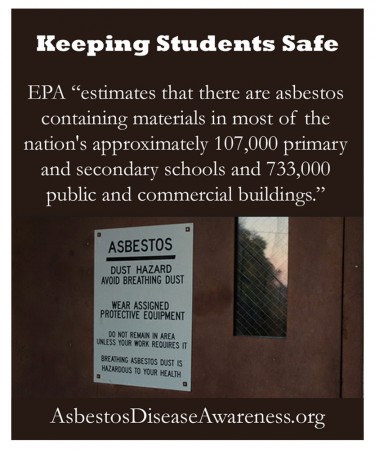Posted on October 14, 2014

Keeping Our Children Safe.
Like many schools that undertake large-scale modernization projects, the Ocean View School District (OVSD) in Huntington Beach, CA faces asbestos abatement risk and management issues. Parents, teachers, and staff became upset when they learned their district may have been removing the material as part of a large-scale modernization project while students were present.
Ocean View School District Superintendent Gustavo Balderas finally decided to close Lake View indefinitely after test results confirmed asbestos in several classrooms.
I was horrified to hear what teachers and parents shared with me — that dust has been seen and cleaned up in their classrooms.
Currently, Lake View, Oak View and Hope View schools remain closed until the testing and results are made public.
On October 10, 2014, The Los Angeles Times reported, “Of the 56 wipe samples collected at Hope View, one sample taken in Classroom 6 contained a single asbestos fiber. It was collected under a tile that appeared to have been drilled into in order to run television wires into the classroom, said Cary Ruben, a certified industrial hygienist.”
According to the U.S. Consumer Product Safety Commission, asbestos fibers can be released into the air during demolition work, repairs and remodeling. Asbestos was widely used in building products and insulation materials in to the early 1980s.
Each day, 30 Americans die from preventable asbestos-caused diseases and without a ban, asbestos exposure and imports continue. The United States Environmental Protection Agency (EPA) “estimates that there are asbestos containing materials in most of the nation’s approximately 107,000 primary and secondary schools and 733,000 public and commercial buildings.” In 1986, the United States signed the Asbestos Hazard Emergency Response Act (AHERA) legislation into law, requiring “local educational agencies to inspect their school buildings for asbestos-containing building material, prepare asbestos management plans and perform asbestos response actions to prevent or reduce asbestos hazards.” AHERA also tasked the EPA with “developing a model plan for states for accrediting persons conducting asbestos inspection and corrective-action activities at schools.” The EPA states that “one study estimated that 3,000 different types of commercial products contained asbestos. Many older plastics, paper products, brake linings, floor tiles and textile products contain asbestos, as do many heavy industrial products such as sealants, cement pipe, cement sheets, and insulation. It is still legal to manufacture, process and import most asbestos products.”[2] The OVSD problem will not be quickly resolved and it will take years for faith and trust to be re-established. I urge you to join ADAO’s efforts to protect public health. It is heartbreaking and unconscionable that asbestos exposure continues in our elementary schools. We will provide updates to the Huntington Beach case as we learn more details. I’ve attended two District meeting so far to offer support and information In unity, Linda [1] http://www2.epa.gov/asbestos/asbestos-laws-and-regulations#ahera [2] http://www.epa.gov/region6/6pd/asbestos/asbgenl.htm
